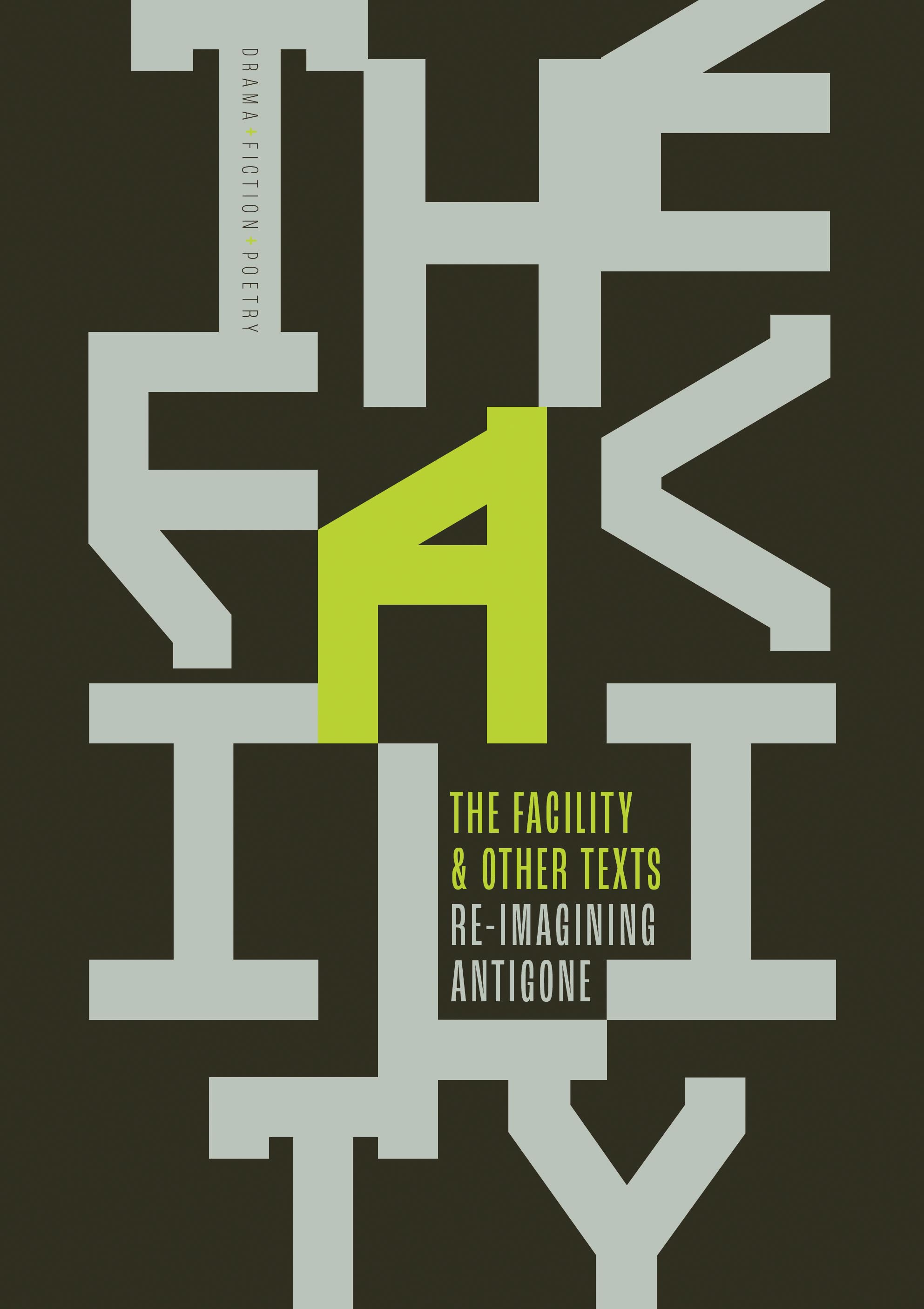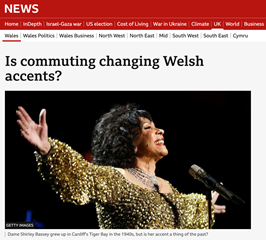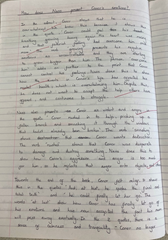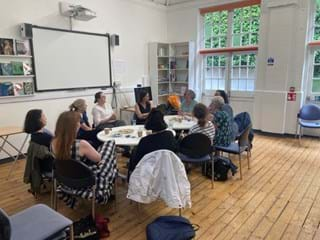The teachers
Katie shares her mixed attainment Year 9 class with her colleague, Sally – they both see the class for two hours a week. This class spent seven lessons reading and responding to the play.
Anmika also taught the play to her mixed attainment Year 9 class, across a sequence of eight lessons, with three 50-minute lessons per two-week cycle.
Why teach a modern play at KS3?
The Facility and Other Texts is an anthology that is part of the EMC’s Cultural Conversations series. It includes the play ‘The Facility’, a re-imagining of ‘Antigone’ commissioned by the EMC and written by Sarah Hehir specifically for KS3. Two members of the EMC’s Research & Projects Team taught a sequence of lessons on the play, using the free EMC resources available on the website as a starting point. In this blog they reflect on the process of teaching the play, and how students responded.
 Katie: At the moment, our students learn about dramatic texts through their study of Shakespeare – we don’t have a modern play in our KS3
Katie: At the moment, our students learn about dramatic texts through their study of Shakespeare – we don’t have a modern play in our KS3
curriculum. Thinking about it, I don’t think I’ve ever taught a whole modern play at KS3! I know that some schools teach the stage adaptations of popular novels at KS3 (for example, ‘Frankenstein’, ‘The Curious Incident of the Dog in the Night-time’, etc), but I wasn’t aware of many original modern plays suitable for students which were being widely used at this key stage in schools.
When we decided to trial ‘The Facility’ with our Year 9 class, we did have a few reservations: what would the behaviour be like when reading a whole play quite quickly? Would the form feel too unfamiliar to them? Would it ‘fit in’ with what students had been learning previously? Our class is very energetic and vocal, and we wondered how they’d deal with a text that was new to us as teachers, and presented challenging material to a class with limited experience of modern drama in English. We were pleasantly surprised: actually, it was the play form that really engaged students in both the reading process itself, and the thinking around the text; and the fact that it was a modern play meant that students responded in powerfully personal ways to the setting, story and themes, seeing echoes of the play’s ideas in their recent work on dystopian fiction, and in the real world.
Anmika: I also taught ‘The Facility’ off the back of a Dystopian unit. The unspecified location of ‘the facility’ and the title itself opened interesting conversations about the genre and setting. The first few lessons of the sequence particularly, where students considered the play as an adaptation of the Athenian tragedy and the other adaptations that had been written before, helped the class reflect on what other stories had been told time and again in history. They were drawn in by the idea of shifting the genre of a popular story, to change the message or refresh a well-known tale. I chose to teach the sequence as it is planned – with the two lessons of pre-teaching before reading the play. Students had a go at planning their own adaptations of the original before we read ‘The Facility’ and then some returned to this after reading too.
Katie: Although ‘The Facility’ is a modern re-telling of ‘Antigone’, our students felt it stood up on its own as an ‘interesting’ and ‘intriguing’ play. In our teaching sequence, we did begin with the plot overview of Sophocles’ ‘Antigone’, but students recognised that the play worked on its own terms too:
If the names were different, I would have no idea it was based on Antigone, which I liked.
The fact that the play could be used as a way in to exploring classical tragedy, or explored as a standalone text, meant we could discuss its place in the tradition of tragedy at times and focus on it as a modern play at others – it feels like there’s plenty of scope for taking the learning in different directions, which is great.
How did different students engage with the text?
Katie: Something that became clear to us was that many of our students were engaged by the process of reading this relatively short modern play: drawn in by the pace of the action unfolding, enjoying the opportunity to take responsibility for reading a character and the ease of reading a script instead of dense prose. One of my students, who is dyslexic and sometimes struggles to focus, found the play really helped to keep them focused, particularly when they were given a character to read and this meant they ‘actually enjoyed’ reading in class – a bit of a breakthrough moment for them, as they hadn’t previously engaged so well.
Anmika: I also found the nature of the play to be one my students were really excited by! I was apprehensive at first as it is quite different from anything we have read before, and it’s quite challenging, for example it conforms to the traditional structure of a Greek tragedy with the chorus playing an important role – I didn’t know if they would get this feature or enjoy it. But they really did, especially the students who are usually more disengaged with English and reading. I had to have a waiting list each lesson for reading parts, and the chorus quickly became the favourite part to read. Students managed and directed this themselves – ‘Miss, I think we need 6 members of the Chorus for this section’, alternating the lines and reading in unison at different moments.
Katie: I hesitated before asking students to perform part of the chorus in groups, which is a suggested activity in the EMC resources. It felt risky letting go of the reins (what if a would-be Antigone incites some kind of rebellion?) but this activity involved some of the best and richest learning the class did during the sequence. Students chose their own small groups of two or three (what was I thinking?) – but rather than leading to disruptive behaviour, this turned out to be an important way to get the best out of the students: with the security of their friends, less confident students were able to rehearse ‘under the radar’ without feeling as exposed as they might in a group of more dominant classmates, and more dominant students quickly realised that conveying the Chorus effectively required teamwork, listening, and co-ordination. When I asked why performing part of the play like this might help them, students showed insight about how the process encouraged them to engage with the details of the text: ‘Miss, we’re kind of analysing it as well, aren’t we?’
Anmika: I too was impressed with the variety of interpretations in the room during this activity. One group had chosen to have a student lying across the table while the others stood in a row behind him, the student lying down was then the one who read the lines to do with the death of Polynice. Others worked with props. Students had clearly thought about the way the lines sounded out loud. One wrote:
We took turns to say lines, to create a characterisation of each person, but said some lines in unison to add emphasis onto them. We were also planning to slightly overlap some dialogue to create rhythm and a flow of people gossiping.
While a drama activity might not be your go-to regular English lesson, I found that letting the students actually perform the play we had been reading was an excellent way to engage them further in the text and see that their choices can impact the text beyond just reading out loud.
Katie: I agree! Allowing students to actually try out the text felt like a really important way to keep the dramatic form in focus. Admittedly, the group work wasn’t neat and tidy, quiet or polished – but it wasn’t a distraction, either. Rather than diverting students away from the reading of the text, it enhanced it.
What kind of writing emerged from our lessons on ‘The Facility’?
Anmika: I was surprised by the quality of the ideas that emerged from students’ writing about the play. During the quick first reading, I built in opportunities for students to record their ideas and respond to the play through writing. I found that the lack of formality in lots of this writing was really useful and meant students were able to express themselves clearly and succinctly in response to the play. For example:
Student A It is about people resisting oppression by tyrants and dictators. Many people like a story where an underdog comes up through levels of importance.
Student B This is a story about tragedy, death and the consequences of power and control.
Student C This is a story about what happens when you have no mercy.
Student D All decisions have consequences for important people. I think the story shows that life is complicated and it relates the most with society today, how no one is perfect and all actions will have consequences.
Katie: I’m so impressed by your students’ ideas! It surprised me how quickly students seemed to grasp the ‘big picture’ concepts of the play, just through considering the synopsis. It’s asking quite a lot of them to be able to express the central concerns of the play succinctly, but they rose to the challenge – an important reminder that students can often do more than we assume.
Anmika: As we read the play, I found that giving students opportunities for little experiences of writing creatively themselves produced some interesting results. Through their own writing, they were able to show an understanding of the features of traditional Greek tragedy or an appreciation of the different characters’ motivations. For example, before we read the Third Stasimon, students wrote what they thought it might include:
Chorus: Antigone
Fighting the sun
Staggering into the fire
An endless battle
Fighting the many
Knights before the King
How tragic the fall
Of the lone soldier
As she enters the den
Of a creature living in the shadows
Chorus: Did you hear?
Hear what?
The reason that girl died was
Because of the Prison Governor
That Creon fellow?
He’s so snobby
Acting like he’s above us!
Chorus: Motivation Shut up
Dedication Shut up
Change Shut up
Rebellion.
Katie: The images of Antigone ‘fighting the sun’ and ‘staggering into the fire’ are so vivid – and you can see straight away how they’ve internalised the features of the chorus and made them their own.
Anmika: Yes, a grasp of the function of the chorus was really demonstrated through writing it themselves! They really enjoyed these tasks and were eager to share their responses. Some made thoughtful comparisons between their own work and the parts of the play they had predicted. Giving them the opportunity to write creatively also improved the quality of their analytical thinking about the writer’s choices. Here are some examples:
What I liked in ‘The Facility’ was the Chorus. I thought it was a pretty unique technique that helped emphasise important parts of the play and give them more drama using repetition or rhyming.
I liked how it was based in a prison which was poorly governed. The most interesting bit was when Ismene turned the paper into a bird and gave it to the press which symbolises being free. The bit I found most challenging was to do with the Crow character which was Creon’s conscience and how he played a little role but had a big impact in the story.
After reading the play, many students chose to write part of their own adaptation and there were some really thoughtful interpretations. One student set the story in the trenches of WW1. There were two brothers and when one dies in No Man’s Land, the other asks the commanding officer if he can go to find him:
A thought came across my mind that would start a world of pain. And before I could think, I was speaking: ‘Sir I would like to enter No Man’s Land to bury his body.’
Another wrote a mature modern adaptation that was particularly thoughtful:
Polinyces lived next door for 5 years. During that time, I saw his wife leave, his kids leave with her, and who had once been a happy, cheerful man who said hi to me every morning became an empty shell. He never left his house except to go to the corner shop to buy some beer; he was sacked from his job a month later for not going to work, and the bills piled up after that. I say ‘lived’ because they found him yesterday. He jumped off a bridge over the M1. His wife came to his house to organise his stuff before they sold it. I saw her taking some things with her. They looked valuable. My neighbour, Antigone wrote an angry letter to our MP, Creon Clark. He promised extra pay for unemployed people looking for a job, but Polinyces obviously hadn’t got any. I set up a Whatsapp group for people to send stories about his life, so that I could make a remembrance poster. Antigone wasn’t happy with me (‘for god’s sake, Ismene, what’s a poster going to do for the poor man’) but everyone else took it pretty well.
Katie: Our students did less creative writing along the way than your group, but came up with some interesting written responses to the play after we’d finished reading. Avoiding prescriptive frameworks helped students to write genuine personal responses which still employed ‘subject specific terminology’ – but naturally, rather than artificially.
Student A: I enjoyed the way the play left a lot open to interpretation. While many may complain that the story didn’t feel finished, I think that improves it. It means that you are forced to think more on why things happened and why particular things were said – for example, Ismene’s ending speech seemed unexplained as the story ended abruptly after it. I also found Creon’s character arc very interesting – at the start he was very pessimistic and refusing to admit his mistakes but through a windy up-and-down path he eventually admitted what he had done wrong and was honest with his faults and regrets.
Another student wrote about the play less positively, but with a similar engagement with the text as a dramatic construct:
Student B: I liked the idea of the Chorus being multiple characters and their poetic speech. I disliked the lack of death as it is meant to be a tragedy. Antigone is the protagonist but she has no character development.
I hadn’t taught any specific vocabulary to the class during our reading, and yet comments on ‘character arc’, ‘multiple characters’, ‘poetic speech’, ‘tragedy’, ‘protagonist’ and ‘character development’ emerged naturally in conversation and in students’ writing.
Where would we go next?
Anmika: After teaching this sequence of lessons and reflecting on my students’ work, I am full of thoughts about how much possibility this anthology offers. After the first four lessons, we read the play quite quickly and I found myself needing to rush to ensure we finished the play in the time frame we had. I’m certain there are so many possibilities for students to get even more out of Re-imagining Antigone, both the play and the other texts. I would have liked to consider the idea of an adaptation further; read one or more of the other adaptations in the anthology and put them in conversation with the play; pause for more drama activities; embed more writing opportunities: creative, exploratory and analytical. There is so much to consider about the different characters and the play’s structure and form is ripe for discussion and teaching!
Katie: I definitely think the play deserves more time than we were able to give it in our trial. There were times where we were probably moving more quickly through the text than we’d have liked, due to time pressure. At my school we teach in mixed attainment groups, with higher than average SEN and EAL cohorts, so I think taking a bit longer to clarify key aspects of the drama and allowing students more time to digest the main developments would be necessary in a more fully developed scheme to support all students to process what is quite a complex and mature play. Despite the challenging content, I think that teaching ‘The Facility’ at KS3 could offer all students some really rich learning: I mentioned earlier that one of my students with dyslexia found the form easier to follow than a novel, and the physical acting-out of the play is a great way to reinforce meanings and demonstrate the plot for students who are beginning to learn English. At the other end of the spectrum, it feels like there are plenty of opportunities for some really deep thinking about what a play is and has the power to do, the concept of adapting a classic text for a modern audience, and the big, philosophical questions of the play surrounding duty, power and sacrifice, offering plenty of challenge for the top end.
Teaching The Facility – A Route Through




